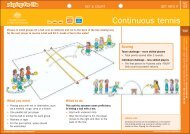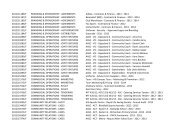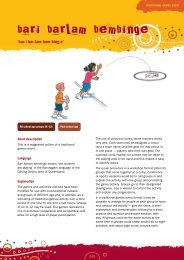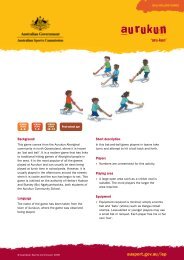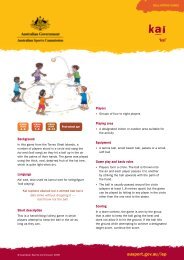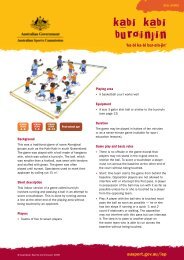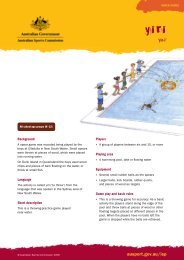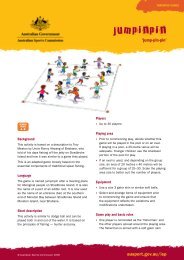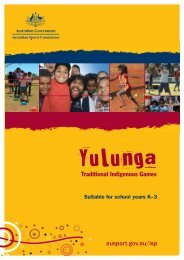the sydney 2000 olympic and paralympic games - Australian Sports ...
the sydney 2000 olympic and paralympic games - Australian Sports ...
the sydney 2000 olympic and paralympic games - Australian Sports ...
Create successful ePaper yourself
Turn your PDF publications into a flip-book with our unique Google optimized e-Paper software.
PART FOUR : NSW GOVERNMENT AGENCIES GAMES SUPPORT SERVICES<br />
• NSWFB Superintendents <strong>and</strong> o<strong>the</strong>r officers shared <strong>the</strong> 24-hour positions of Liaison Officer in <strong>the</strong><br />
Police Olympic Precinct <strong>and</strong> Regional Operations Centre <strong>and</strong> <strong>the</strong> Common Domain Operations Centre<br />
during <strong>the</strong> Games. Officers also attended <strong>the</strong> Olympic Transport Operations Centre.<br />
• NSWFB had <strong>the</strong> ability to activate its Major Incident Co-ordination Centre at Alex<strong>and</strong>ria if a major<br />
incident occurred.<br />
• NSWFB leased electric carts to act as Rapid Intervention Vehicles (RIV) for fire crews to get into <strong>and</strong><br />
around congested areas in <strong>the</strong> Stadium <strong>and</strong> <strong>the</strong> International Broadcast Centre.<br />
• O<strong>the</strong>r supporting vehicles included a prototype four wheel drive RIV, purchased during <strong>the</strong> lead up<br />
to <strong>the</strong> Games <strong>and</strong> used at <strong>the</strong> RAS Fire Station, leased petrol driven Combo vans used throughout<br />
<strong>the</strong> Homebush Olympic site <strong>and</strong> a new Type 4 Urban Pumper trialed at Olympic venues during<br />
<strong>the</strong> Games.<br />
Venue Protection<br />
In conjunction with OSCC, NSWFB developed extensive plans, policies <strong>and</strong> procedures to ensure safety,<br />
<strong>and</strong> adopted <strong>the</strong> following strategies:<br />
• The Fire Safety Division ensured that venues complied with <strong>the</strong> Building Code of Australia.<br />
• Regular inspections of Olympic facilities <strong>and</strong> venues were conducted before <strong>and</strong> during <strong>the</strong> Games.<br />
• Prior to <strong>the</strong> Games an extensive inspection regime was established for Backpackers Hostels <strong>and</strong><br />
o<strong>the</strong>r city <strong>and</strong> suburban accommodation.<br />
• Sufficient resources were strategically located for each venue.<br />
During <strong>the</strong> Games <strong>the</strong>re were three levels of NSWFB response resources for Sydney Olympic Park (SOP).<br />
These were resources within venues, <strong>the</strong> surrounding precinct <strong>and</strong> outside <strong>the</strong> Olympic area. Seven<br />
temporary fire stations were constructed <strong>and</strong> fitted out within SOP, Darling Harbour <strong>and</strong> <strong>the</strong> Media <strong>and</strong><br />
Athletes' Villages.<br />
Road events such as <strong>the</strong> Torch Relay <strong>and</strong> marathons were serviced by deployment of resources at<br />
strategic locations along <strong>the</strong> route. O<strong>the</strong>r venues were supplemented by dedicated external resources to<br />
support venue staff during competition hours. The Urban Domain was supported by increasing staff on<br />
duty <strong>and</strong> providing additional st<strong>and</strong>by equipment. NSWFB worked closely with <strong>the</strong> Rural Fire Service<br />
(RFS) in matters concerning Western venues located in RFS fire districts.<br />
Chemical, Biological <strong>and</strong> Radiological Response<br />
To address <strong>the</strong> risk of terrorism, including a possible chemical, biological or radiological (CBR)<br />
incident, <strong>the</strong> Olympic Security Working Committee brought toge<strong>the</strong>r relevant Commonwealth <strong>and</strong><br />
State organisations.<br />
The following key CBR initiatives were established:<br />
• A CBR awareness training program was provided to NSWFB, Police <strong>and</strong> <strong>Australian</strong> Defence<br />
Force personnel.<br />
• Specialised equipment was purchased to enhance NSWFB’s CBR capability, including chemical<br />
detectors, protective clothing, mass decontamination shelter, bulk storage module for protective<br />
clothing <strong>and</strong> supplies, pharmaceuticals <strong>and</strong> victim identification kits.<br />
• A sampling kit was developed to ensure that substance samples could be taken as soon as possible<br />
after an incident.<br />
• The Hazardous Materials Emergency Sub-Plan (“Hazmat Plan”), which details special arrangements<br />
for all NSW hazardous materials emergencies, was revised to cover CBR. The reissued Hazmat Plan<br />
became <strong>the</strong> overarching plan for <strong>the</strong> State.<br />
• Fire Stations carried out decontamination drills in conjunction with hospitals.<br />
• Nine hospitals throughout Sydney were equipped with permanent decontamination facilities.<br />
71



